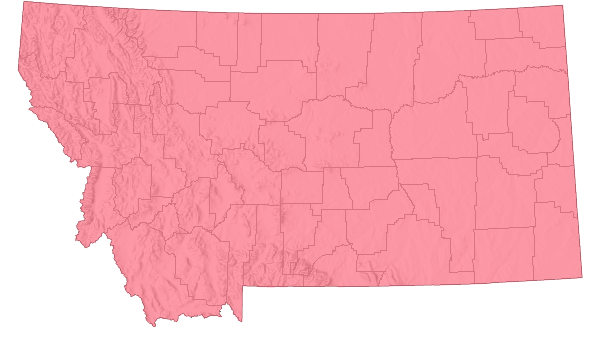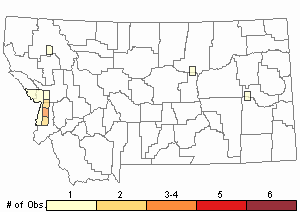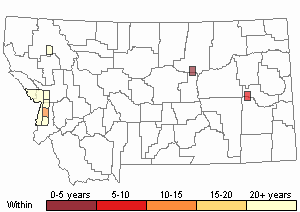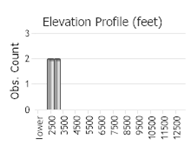View in other NatureServe Network Field Guides
NatureServe
Montana
Utah
Wyoming
Idaho
Wisconsin
British Columbia
South Carolina
Yukon
California
New York
Common Velvetgrass - Holcus lanatus
Other Names:
Tufted Grass, Meadow Soft Grass
General Description
Cool season, perennial bunchgrass. Stems 30–80 cm, covered with dense soft hairs, , often decumbent and rooting at nodes. Leaves: blades 4–8 mm wide, flat and lax to ascending; sheaths with overlapping margins; ligule membranous. Inflorescence a contracted panicle 8–15 cm long, opening up at or after anthesis. Spikelets with 2 florets 3.5–4.5 mm long; glumes enclosing the florets. Lemmas 2 per spikelet; lower floret unawned and fruit bearing, upper lemma staminate and with a hooked awn; palea well developed. Disarticulation below glumes and tardily above the glumes; unit of dispersal the spikelet or floret (Lavin in
Lesica et al. 2012. Manual of Montana Vascular Plants. BRIT Press. Fort Worth, TX).
Diagnostic Characteristics
Holcus lanatus is rarely mistaken for any other species with the possible exception of H. mollis. Holcus lanatus can be distinguished by the purplish coloration on the panicles and veins of the sheaths, soft hairs all over, and lack of rhizomes. The two species may be able to hybridize (Jones 1954).
Species Range
Montana Range
Range Descriptions

 Non-native
Non-native
Range Comments
Velvet grass is of European origin, its center of origin thought to be the Iberian peninsula (Jacques and Munro 1963), and is a native of temperate areas of Europe and Asia (Scoggan 1978). It was probably introduced to North America either accidentally as a contaminant of forage seed or deliberately as a component of seed mixtures for meadow (Thompson and Turkington 1988). It has since spread and become locally abundant from British Columbia to Nova Scotia, Canada, south from Maine to Kansas and Colorado, south to Georgia and Louisiana and in primarily moist areas below 7500 feet along the Pacific Coast from British Columbia to California and to Montana and Arizona (Thompson and Turkington 1988).
Velvet grass is common throughout Europe except the extreme north and northeast where it is only casual (Thompson and Turkington 1988). In England, it is widely distributed in fields, partic- ularly on north-facing slopes (Grime and Lloyd 1973). The grass is now found throughout Asia, Africa, New Zealand, Australia, and sub- Antarctic islands. It has escaped cultivation and become a weed pest along roadsides, fencerows, ditch banks, in old pastures, and other disturbed sites, particularly in moist places (Muenscher 1955). In the Coast Ranges, it has become a weed of minor importance (Robbins et al. 1970).
Observations in Montana Natural Heritage Program Database
Number of Observations: 13
(Click on the following maps and charts to see full sized version)
Map Help and Descriptions
Relative Density

Recency



 (Observations spanning multiple months or years are excluded from time charts)
(Observations spanning multiple months or years are excluded from time charts)
Habitat
Management
Stewardship Responsibility
References
- Literature Cited AboveLegend:
 View Online Publication
View Online Publication Lesica, P., M.T. Lavin, and P.F. Stickney. 2012. Manual of Montana Vascular Plants. Fort Worth, TX: BRIT Press. viii + 771 p.
Lesica, P., M.T. Lavin, and P.F. Stickney. 2012. Manual of Montana Vascular Plants. Fort Worth, TX: BRIT Press. viii + 771 p.
- Additional ReferencesLegend:
 View Online Publication
View Online Publication
Do you know of a citation we're missing? Lesica, P., M.T. Lavin, and P.F. Stickney. 2022. Manual of Montana Vascular Plants, Second Edition. Fort Worth, TX: BRIT Press. viii + 779 p.
Lesica, P., M.T. Lavin, and P.F. Stickney. 2022. Manual of Montana Vascular Plants, Second Edition. Fort Worth, TX: BRIT Press. viii + 779 p.
- Web Search Engines for Articles on "Common Velvetgrass"





